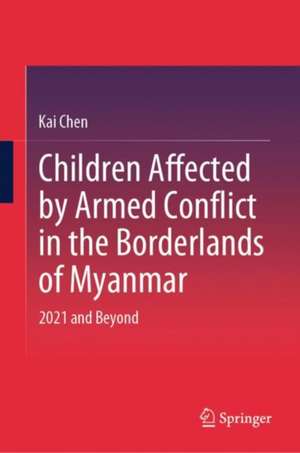Children Affected by Armed Conflict in the Borderlands of Myanmar: 2021 and Beyond
Autor Kai Chenen Limba Engleză Hardback – 3 sep 2024
Preț: 692.41 lei
Preț vechi: 814.60 lei
-15% Nou
Puncte Express: 1039
Preț estimativ în valută:
132.49€ • 138.70$ • 109.63£
132.49€ • 138.70$ • 109.63£
Carte disponibilă
Livrare economică 15-29 martie
Preluare comenzi: 021 569.72.76
Specificații
ISBN-13: 9789819727391
ISBN-10: 9819727391
Pagini: 175
Ilustrații: Approx. 175 p.
Dimensiuni: 155 x 235 mm
Greutate: 0.3 kg
Ediția:2024
Editura: Springer Nature Singapore
Colecția Springer
Locul publicării:Singapore, Singapore
ISBN-10: 9819727391
Pagini: 175
Ilustrații: Approx. 175 p.
Dimensiuni: 155 x 235 mm
Greutate: 0.3 kg
Ediția:2024
Editura: Springer Nature Singapore
Colecția Springer
Locul publicării:Singapore, Singapore
Cuprins
1. Introduction.- 2. Children Affected by Armed Conflict in the Western Borderlands of Myanmar.- 3. Children Affected by Armed Conflict on the Myanmar-Thai Border.- 4. Children Affected by Armed Conflict on the Myanmar-China Border.- 5. Children’s Insecurity in the Rest of Myanmar.- 6. Displaced Children from Myanmar in the Neighbouring Countries.- 7. What the Stakeholders Have Done to Protect Children from Armed Conflict.- 8. Obstacles Facing the Stakeholders.- 9. Humanitarian Ceasefire: Most Possible Scenario for Protecting Children Affected by Armed Conflict in the Borderlands of Myanmar.- 10. Conclusion.
Notă biografică
Kai CHEN, Ph.D., is an assistant professor at the School of International Relations, Xiamen University, and an academic visitor affiliated with the University of Oxford China Centre (2021-2022). His principal research focuses on the nexus between human insecurity and international relations, especially children affected by armed conflict in the borderlands of the developing countries. His previous positions include post-doctoral fellow at the School of Public Administration, Zhejiang University, and post-doctoral fellow at the School of International Relations and Public Affairs, Fudan University. He has held visiting appointments at the University of Oxford, King’s College London, National University of Singapore, Kyoto University, Lund University, Cardiff University, Universiti Brunei Darussalam, and Chulalongkorn University. He is the author of Children Affected by Armed Conflict in the Borderlands of Thailand (Springer, 2021).
Textul de pe ultima copertă
This book focuses on children affected by armed conflict in the borderlands of Myanmar since the regime-change event in 2021. In the borderlands of this country, uncountable children have been killed or maimed by indiscriminate weapons, raids, artillery bombardments and air strikes. Concerning the Burmese children living in the rest of Myanmar, they have been exposed to feelings of insecurity and growing anxieties caused by deadly bombings and assassinations. No place in Myanmar is immune from armed conflict. Many displaced Burmese children fled into the neighboring countries, which did not ratify the 1951 Refugee Convention. With no refugee status, some displaced children faced the risk of being arrested and deported. Some displaced children became victims of human trafficking, or led a life of vagrancy. The stakeholders responsible for protecting children from armed conflict, have been promoting Myanmar towards reconciliation in their own ways. However, the stakeholders had to deal with three obstacles, that is, lack of consensus, insufficient cohesion and funding gap. When a national ceasefire is unavailable in Myanmar, the conflicting parties would probably welcome a humanitarian ceasefire in the borderlands of this country, rather than wearing each other out. In the case of Myanmar, a humanitarian ceasefire should be composed of three parts: immediate access to victims of armed conflict, safe passage of civilians, and release of detainees in batches. If everything goes well, an agreement for a humanitarian ceasefire in the borderlands of Myanmar, would be followed with peace talks in the foreseeable future.
Caracteristici
Explores how armed conflict has affected children in the borderlands of Myanmar since the regime-change event in 2021 Analyzes the obstacles facing the stakeholders in protecting Burmese children from armed conflict in the borderlands Advocate "humanitarian ceasefire" to reduce armed conflict in the borderlands of Myanmar
